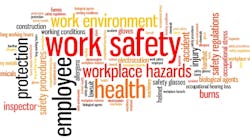U.S. Occupational Safety and Health Administration (OSHA) reporting requires companies to track metrics like total recordable incident rate (TRIR), lost time incident rate (LTIR), and workers’ compensation costs. The problem is that while these metrics describe the effectiveness of safety programs, they’re only half the story when it comes to preventing incidents.
Tracking leading safety indicators, on the other hand, provide a forward-looking measure of safety risks in the workplace. Developing leading safety indicators—though not required for regulatory compliance—is a best practice that helps Environmental, Health, and Safety (EHS) leaders step in before incidents occur.
So which leading safety indicators should companies track, and how can they use them to gain greater insights into safety risks?
Here we explore the basics of leading safety indicators, including practical examples, insights, and how to track leading indicators in your organization.
What Are Leading Safety Indicators?
Leading safety indicators measure events and activities that precede safety incidents, while lagging indicators describe outcomes that have already taken place. Leading indicators are predictive, helping provide early warning of problems and identify potential corrective actions. Examples of leading indicators include number of training hours completed, number of hazards identified, and average time to close out corrective actions.
Leading Indicators: An Everyday Analogy
Car maintenance provides a simple illustration of how leading indicators work. Here, low engine oil and rising engine temperature are two examples of leading indicators, with the number of breakdowns being a lagging indicator.
Leading indicators also often describe prevention activities. In this example, that would include actions such as checking your oil regularly, getting your oil changed at the recommended interval, and taking your car in for routine maintenance. Monitoring these activities is much more effective than simply waiting for a breakdown to occur before addressing problems.
Examples of Leading Safety Indicators and Insights
Leading indicators are individual to each company and must be developed based on actions and events that correlate with changes in lagging indicators. There are several key places that EHS leaders can look when starting to determine which metrics to track.
Examples include:
√ Corrective action metrics like number of overdue items and time to completion
√ Employee training metrics such as on-time completion or number of training hours
√ Worker participation in activities such as safety meetings
√ Behavior-based safety metrics like number of unsafe observations logged
√ Number of new hazards identified over a given period
√ Number of new controls added over a given period or percentage of identified hazards with a control
√ Compliance activities such as regulatory change tracking and maintaining compliance calendars
√ Investment in safety programs and technology
From Insight to Action
By tracking how metrics in these areas correlate with lagging indicators, you might gain insights such as:
√ When there is a large backlog of overdue corrective actions, safety problems are more likely to reoccur
√ Employees with more training hours have fewer incidents
√ When the number of unsafe observations identified in a specific work cell go up, so do injuries
√ A spike in near-miss incidents precedes a spike in employee injuries
√ The number of new controls added correlates with fewer incidents and/or external audit findings
Finally, based on those insights, companies can identify the right corrective actions to drive the desired change in their lagging indicators. For instance, you might require more frequent safety walkthroughs or spearhead a project aimed specifically at clearing your backlog of corrective actions.
Why Tracking Leading Indicators is Critical to Safety Management
Tracking leading safety indicators is a proactive strategy for preventing workplace injuries, helping identify safety risks that need to be addressed. They also are the key to improving performance on lagging safety metrics.
Benefits of monitoring leading indicators include:
√ Demonstrating leadership’s commitment to safety
√ Improved safety program performance
√ Increased efficiency and productivity
√ Reduced costs associated with workplace incidents and production inefficiencies
√ Fostering a culture of safety
How to Get Started with Leading Indicators
Each organization must develop its own leading indicators from internal EHS data. Leading indicators are correlated with lagging metrics, making it important to analyze your own data to see which metrics have predictive power.
OSHA recommends starting with your top hazards, reviewing injury logs and hazard assessments. Metrics should follow SMART principles, where each metric you choose is Specific, Measurable, Accountable, Reasonable, and Timely. The agency identifies three ways companies can develop leading indicators:
√ Using data you already collect: This can be easiest if you’re just starting out with leading indicators, for instance looking at training attendance or near-miss data.
√ For controlling a specific hazard: An example here would be if you measured whether daily housekeeping checks correlate with reductions in slip, trip, and fall incidents.
√ For improving an element of your EHS program: Leading indicators can help companies strengthen elements of their safety programs such as worker participation, hazard identification, and hazard prevention.
The Campbell Institute at the National Safety Council has also published detailed research on leading indicators. Its Practical Guide to Leading Indicators provides a detailed look at metrics related to operations, systems, and behaviors, with in-depth case studies on how organizations have used them to improve safety.
The Role of EHS Software
Creating and tracking leading indicators requires the ability to gather a variety of EHS data and use it to draw larger conclusions about how to improve your safety program. This gives companies with EHS software a key advantage in monitoring leading indicators, providing a central source of data and tools to identify patterns over time.
For example, companies can use Dakota Software’s ProActivity Suite to gather data from and develop metrics on:
√ Compliance calendars and track overdue items
√ Incident reports and OSHA 300A logs
√ Corrective action
√ Root cause analysis findings
√ Internal audit findings and follow-up activities
Armed with this data, EHS leaders are equipped to develop a range of preventive actions to keep their safety programs on track, prevent injuries, and achieve ongoing compliance. Reporting within the ProActivity Suite reduces paperwork and puts the focus where it belongs: identifying trends from your data so you can take action before problems occur.
Traditional EHS reporting may focus on reactive metrics such as days away from work and incidence rates. But to achieve improvement in these metrics, companies must proactively track the events and actions that drive safety outcomes. EHS software provides a key tool for creating and tracking leading metrics, giving companies the power to see inside their data, gain new insight, and reduce workplace safety risk.
View Dakota’s Demo Video library to get a better understanding of what software can do for you.


